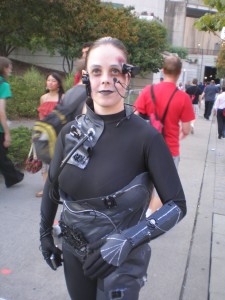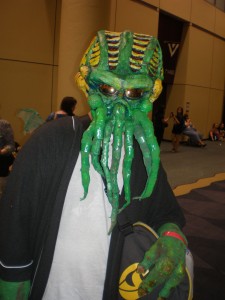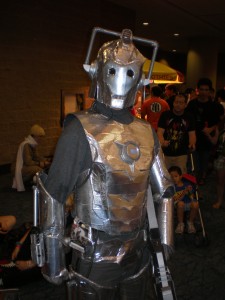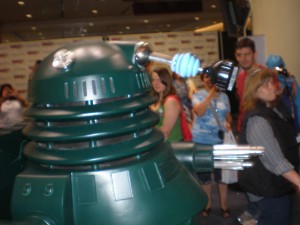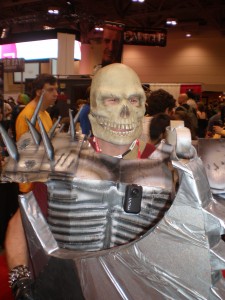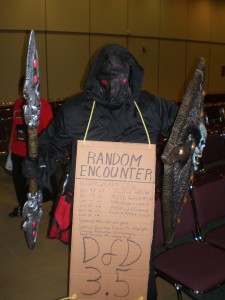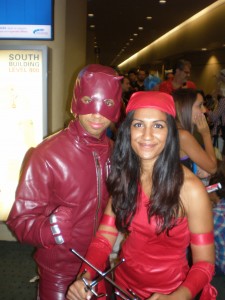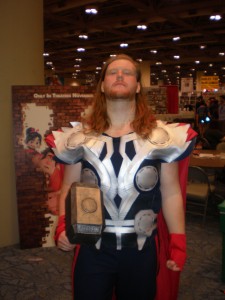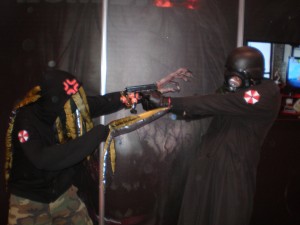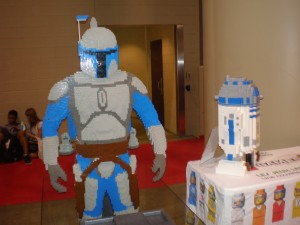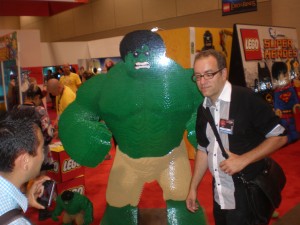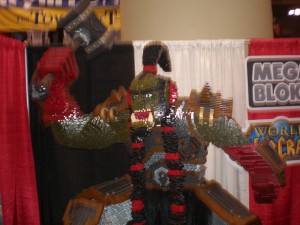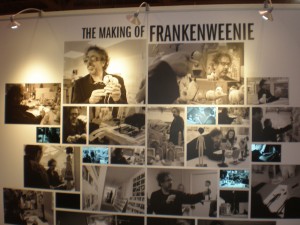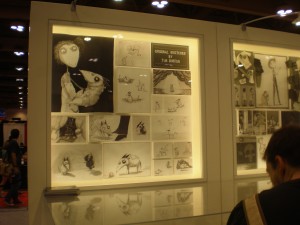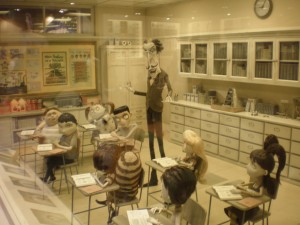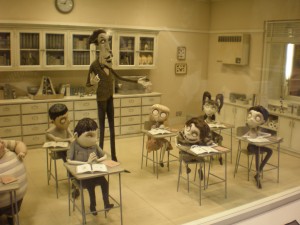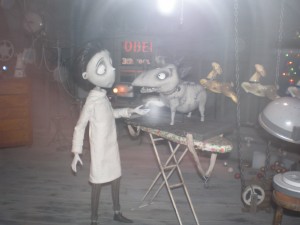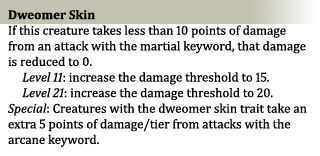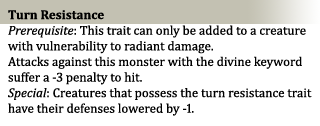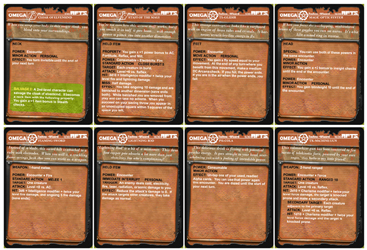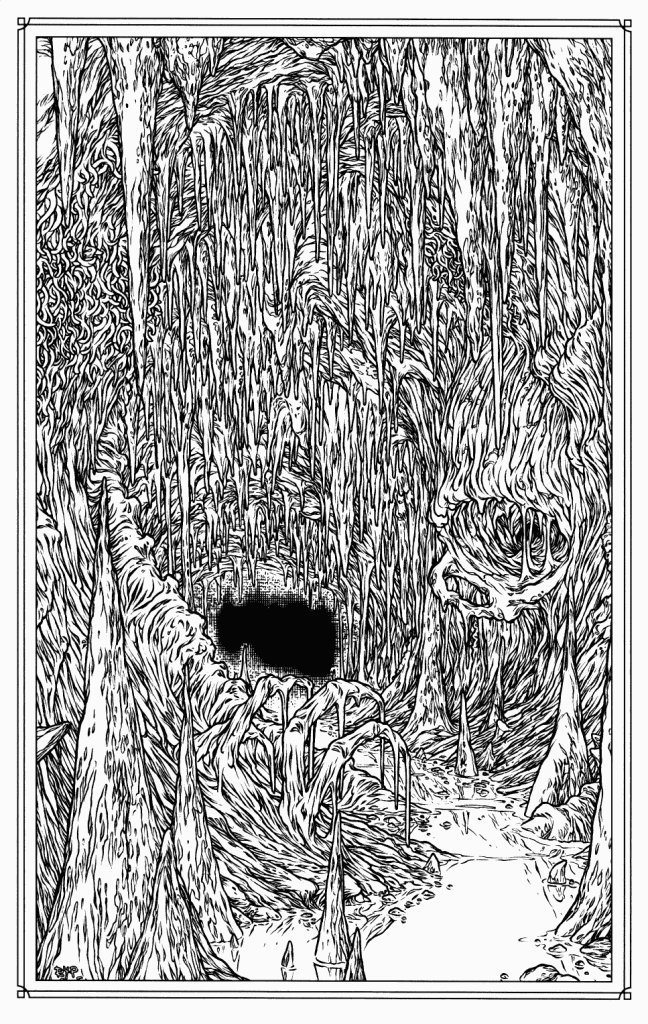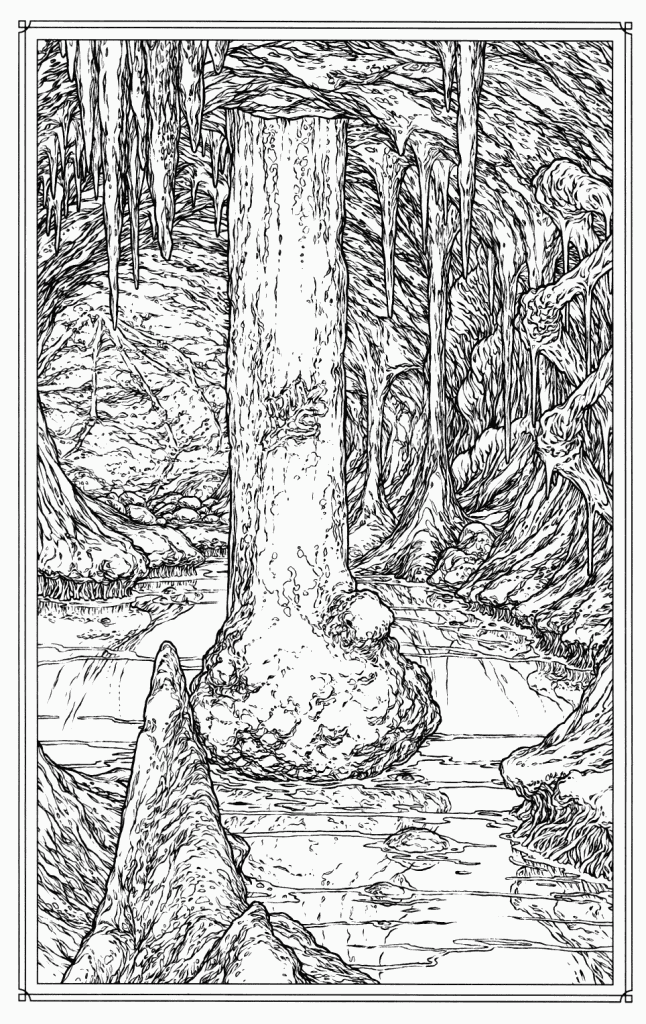Posts Tagged ‘Comics’
The Monster Does Fan Expo – Part 1, Highlights
August 29, 2012I have a lot of love for conventions (I even wrote a play about one – 2007’s GeekGasm at the Toronto Fringe Festival). Getting caught up in the atmosphere of positive energy at these events really recharges my batteries. If you’ve never been to a con, I can’t recommend it enough. At the risk of sounding flaky, they really do feel like a gathering of the nerd tribes, and I think a lot of what I love about the atmosphere comes from the carnival-like vibe and the opportunity for those attending to openly express their geeky passions without self-consciousness or irony.
This weekend I was a part of the horde that descended on downtown Toronto for Fan Expo (cheers to all the folks I got the chance to chat with). For those unfamiliar with the convention, Fan Expo is essentially Canada’s version of Comic-Con with the unique feature of bringing together the fandoms of comics, science fiction, anime, horror and gaming under one roof. That mixing of genres is one of the reasons I try and attend Fan Expo every year – not only do my own interests cross many of those borders, but I appreciate the opportunity to be exposed to something new that I wouldn’t necessarily have encountered in my own circles.
As usual Fan Expo did not disappoint, and I’m happy to say that gamers were especially well represented this year with an excellent roster of celebrity guests and seminars (I’ll cover that specifically in part two). For now, here are the highlights (please excuse my crappy photography).
Costumes
I am continually impressed by the great costumes I see at cons. Seriously, these costumes aren’t only a great showcase of artistic talent and attention to detail but also a triathlon-level display of endurance and fortitude (shuffling around for eight hours with thousands of people is hard enough when you can breathe properly and use the bathroom easily). I salute you! (click to enlarge)
Lego
Hasbro were in full effect with a large pavilion on the show floor and some great Lego displays. Too bad WOTC weren’t there to join them.
Frankenweenie
There was a wicked Frankenweenie pavilion with sets and stop-motion models from the upcoming film. The level of detail was incredible, and since most of it will probably be impossible to see in the movie it was nice to have the opportunity to appreciate it up close (any props you see with writing on them are actually legible – most filled with references to Burton’s body of work).
Toronto After Dark
A personal highlight at this year’s Fan Expo was finally meeting Adam Lopez and the rest of the folks from the Toronto After Dark film festival for a face to face chat. Not only did they have one of the coolest t-shirt designs at the con (Cthulhu devouring the Bloor Cinema), I was able to get the scoop on the festival’s first 10 films: Rec 3: Genesis, Excision, Universal Soldier: Day of Reckoning (featuring the return of Dolph Lundgren and Jean Claude-Van Damme!), Grabbers, A Fantastic Fear of Everything, Dead Sushi, Doomsday Book, Wrong, Lloyd the Conqueror, and Sushi Girl. A very promising lineup. With the addition of the Darkcade (a showcase of indie video games), things are shaping up very nicely for the festival in October.
It Came from Toronto After Dark: VS
February 3, 2012These It Came from the DVR articles are going to be a little bit different. As an early Christmas present to myself, I picked up a festival pass to the Toronto After Dark film festival. So the first difference is that these are new movies, on the big screen, instead of old ones and niche programming on the small screen. The second difference is that these are going to be short. I’ve got eighteen films to see in seven days (as well as dressing up for the annual zombie walk), so I’m not going to have a whole lot of time to write, and I want post these while the blood is still fresh.
Toronto After Dark is a horror and genre film festival oozing with gobs of monster and rpg inspiration, but most of the films it showcases won’t see wide release – so in addition to extracting some rpg goodness from each movie, I’ll also give them a bit of a critique, so fellow gamers can know what they need to track down and what to avoid. I’ll try and keep spoilers to an absolute minimum.
VS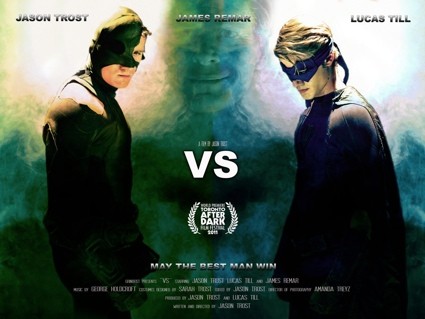
This superhero thriller jumps headfirst into the story, opening with former teammates Charge, Cutthroat, Shadow and the Wall kidnapped by their arch-nemesis Rickshaw. The four heroes awake in a small town, their powers nullified by a mysterious injection and the populace tied to clusters of high explosives. In order to save the trapped innocents, and themselves, they must complete a series of fiendish tests before Rickshaw detonates the bombs and obliterates the entire town.
Super Hero Action Meets Dark Thriller
VS is another ambitious indie film (I like this trend) that shoots for the moon. It stumbles, but there is genius there, and its sheer ballsy-ness makes me want to overlook the film’s shortcomings. Throwing superheroes into a Saw-esque thriller, is an idea worthy of the Joker (in spite of being a Marvel standard bearer, there are a few DC characters that I like) – so is writing, directing and starring in your film, but Jason Trost manages to pull it off without it looking like a vanity picture.
Because of the look of the costumes, it’s easy to compare VS to Kick-Ass. They may share some similarities, but they are as different as night and day. Both films draw on the ‘real-life superhero movement’ for aesthetic inspiration (hence the similar costumes), and both are a comment on the superhero genre. However, Kick-Ass is a spoof that throws superheroes into our world to send up the inherent ridiculousness of the entire genre (that’s not a slam against Kick-Ass – I happened to like it quite a bit), while VS is a straight superhero tale that draws on the language of horror films to showcase a truly sadistic villain.
And what a great villain to showcase. Veteran James Remar steals the show as Rickshaw, having fun with the role and making it crazy enough to be entertaining but keeping it this side of cartoony (a little over the top is fine – it is a superhero movie). In the Q+A Trost revealed that Remar is an old family friend and did the film as a favor (he liked the script too), which is a good thing for VS; because in the hands of someone the film could afford, I’m not sure the character would have worked.
The tests that Rickshaw puts the heroes through are fantastically evil, and as I mentioned, are very much in the tradition of Saw. There’s also a long tradition of these kinds of traps in comics, particularly the kind that involve difficult decisions that put the heroes’ morals in jeopardy – so the mixing of the two genres works perfectly and is the film’s real genius. Convoluted traps and villains toying with their prey seem completely at home in a superhero film without straining credibility (in fact, the audience expects it), while the dark and gritty horror film trappings tell the viewer that the stakes are much higher than a traditional comic book film and that the body count likely will be as well. This gives the characters’ actions a lot of weight and boosts the dramatic tension much more than you would expect from a film about superheroes.
VS’ second moment of genius, and the part of the film that makes it required viewing for any Hollywood director looking to adapt a comic book for the screen, is how Trost deals with the heroes’ backstory. Instead of spending the first half of the film detailing how the characters acquired their powers, and formed their team, VS just cuts to the interesting part of the story (waking up powerless in a town filled with deadly traps) and trusts that the audience is smart enough to fill in the blanks as the story unfolds. Through short flashbacks and character chatter we’re given all we need to know without lots of boring exposition and wasted screen-time. With VS, Trost proves once and for all that it is possible to make an exciting superhero film right out of the gate.
With the low budget Trost wisely wrote out the costly use of superpowers, and relied entirely on practical effects and stunt work. Normally I would have wanted to at least see someone fly or lift up a car in a comic book movie, but the low-fi look really fits with the dark and grimy atmosphere of the film.
Where VS stumbles is in the film’s pacing. Each of the tests is timed, and the heroes must race against the clock to both overcome the challenges and find Rickshaw before the countdown expires and the whole town blows up. That’s a great device to create natural tension, but unfortunately, every time the viewer starts to worry VS shoots itself in the foot by having its characters get into a drawn out conversations and arguments. There were times when I felt like yelling at the screen, “at least walk and talk, you’re all going to die!” I couldn’t help but wonder as the horrible consequences of the countdown unfolded, that it all could have been avoided if the characters hadn’t been so chatty.
VS is recommended for superhero fans, especially those that are ready for a fresh take on the genre. If, like me, you‘re also a fan of horror films, then VS is happily a chocolate and peanut butter situation. It isn’t perfect, but the high points of VS are well worth the lows.
RPG Goodness
If you play a superhero rpg and want to run a game with the grittiness of the Punisher, but prefer costumes to guns, then VS is the best guidebook you can find. I can totally picture combining the D20 version of Mutants and Masterminds with the list of traps from the Dungeon Master’s Guide to create an adventure very similar to the scenario in the film. Even though the movie doesn’t contain any supernatural elements, I think VS would also work as an introduction to set the tone for a mash-up of Palladium’s Beyond the Supernatural and Heroes Unlimited (I’m not sure if anyone has ever played that – but now that I mention it I kind of want to try it out).
Outside of the film’s obvious inspiration for superhero rpgs, I think that VS highlights an issue in D&D that has been dealt with very differently across the editions of the game – nullifying PC powers. While I don’t think there are any adventures that feature the PCs getting injected with a potion that prevents them from using their abilities, many of the old-school modules are filled with walls that can’t be climbed by Thieves, damage that can’t be healed by the Cleric, and lists of spells that Magic Users are barred from casting to bypass an obstacle (the classic adventure Tomb of Horrors is big on this). Starting with 3e, this kind of adventure design was frowned on and often criticised. DMs were encouraged to work with a PC’s powers rather than work around them. When it comes to this issue I am unapologetically in the camp of the new school. Having your character’s abilities hamstrung just so an adventure can railroad your actions is not fun. I would just as soon have choices I can’t use removed from the game rather than have the illusion of choice.
As strong as my stance is on negating PCs’ powers in adventure design, when it comes to monsters I feel differently. I love the beholder’s anti-magic cone, a ghast’s resistance to turning and the thought eater’s special attacks against psionic characters -even though all these creatures nullify class powers in their own way. This might seem hypocritical, but I think the difference between a monster and an adventure is that the monsters in these cases are rare (although if you had an adventure with nothing but ghasts it wouldn’t be much fun for the cleric – or anyone really), their powers are discreet, and rather than reducing a character’s options to a single path (you can’t pick that lock or use a knock spell, you have to find the magic key in room 18 to proceed), these monsters interact with each of the classes in a unique way that makes them frightening and interesting (a golem is immune to most spells, but a few thematic ones affect it in unique ways).
In 4e, which introduced the concept of power sources, this is the feature I expected to interact with those classic monsters, an exciting possibility I thought was wasted (as it turns out, power sources weren’t used for much of anything) – something I’ve lamented before. To remedy this, I’ve created a sampling of traits that can be added to monsters that can transform them into ‘kryptonite’ for certain classes.
Power Sources and Monsters
The following traits can be added to a monster to modify the way the creature interacts with the power sources of the PCs. These traits are minor enough that adding one as-is shouldn’t alter a monster’s level or experience value, although in certain powerful combinations you may instead use it to replace an existing trait or power. Care should be used in placing these traits – there is little point giving a monster anti-magic shell, if there are no arcane characters in the party and the turning class feature will seem pointless if every undead opponent the party encounters has turn resistance.
Random Encounters: Techno-Wizardry in Gamma Rifts
March 10, 2011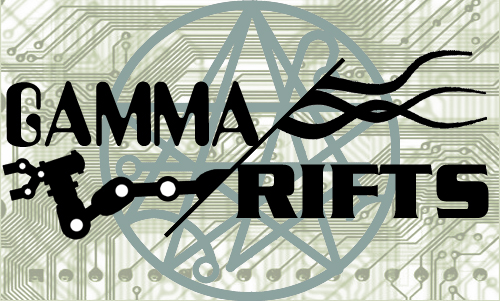 Techno-Wizardry is the hallmark of the Rifts game, epitomizing the setting’s mixture of high-tech and high fantasy like nothing else. There were other ‘kitchen sink’ settings that combined elements of science fiction and fantasy (as early as 1977 Dave Hargrave introduced the Techno class in the Arduin Grimoire), but Rifts was the first game that I ever played where they were so thoroughly blended.
Techno-Wizardry is the hallmark of the Rifts game, epitomizing the setting’s mixture of high-tech and high fantasy like nothing else. There were other ‘kitchen sink’ settings that combined elements of science fiction and fantasy (as early as 1977 Dave Hargrave introduced the Techno class in the Arduin Grimoire), but Rifts was the first game that I ever played where they were so thoroughly blended.
When my friends and I played Rifts in high school, we were fascinated with the concept of Techno-Wizardry, especially the rules for modifying and creating your own items (unfortunately, all we ever added to our vehicles were spoilers and bitchin’ flames on the side – we failed most of our rolls to add anything useful – go figure). Later, when I had grown dissatisfied with the system and 3e D&D came along, the clean item creation rules were something I appreciated. The Gamma World rules don’t support creating your own items (I think having to fix a vehicle or pilot a giant robot would make an awesome skill challenge), but the Omega cards are the next best thing (and some are salvageable – which simulates item creation).
Continuing from my previous post on Omega Tech cards for a ‘Gamma Rifts’ game, I present the next 10 cards in the set of 30: the Techno-Wizard origin (just click on the picture at the bottom of the post for the full PDF). To make it easier to print out with the last 10 cards (the Magic origin), I’ve just added these to a single PDF.
I followed the same pattern as with the Magic origin cards, including 2 salvageable items, but I made sure that they occupied different item slots so there wasn’t overlap (so now we have a neck, weapon, hands, and armor item in total).
Like the last set, many of the Techno-Wizard items had a suite of powers, so I tried to distill them down to their bare essence. I also had a hard time finding consumable TW items other than psi-cola, so I created the teleport grenades out of whole cloth (grenades seem popular in the Omega cards).
One final word on Techno-Wizardry. I’d be remiss if I didn’t mention Dr. Doom from Marvel comics (he is the namesake of my handle and one of the greatest villains of all time), the original Techno-Wizard. From his first appearance in Fantastic Four #5 (1962), he has always been depicted as using black magic and super science hand in hand. Given the popularity of the comic, and that it predates OD&D by nearly a decade, I’ve always wondered if the character was one of the influences on the proliferation of genre crossover in early D&D products (especially in early 3rd party books). Kevin Siembieda did work on those early Judges Guild products… who knows what the connection is (maybe Rifts was just tapping into that vibe he saw in the early RPG field)? My love of Doctor Doom tempted me to include one or two of his signature items in the set, as a tribute to the grandfather of Techno-Wizardry, but I figured I’d save it. Maybe after I finish this set of Rifts Omega cards I’ll make a small set of Marvel inspired ones (given that I’ve already mentioned my previous Rifts game included Captain America’s shield, there’s a pretty good chance of this happening).
Soon to come: the final installment of Gamma Rifts Omega Tech, Splugorth items!
H.P. Lovecraft, Allan Moore and the Underdark
March 2, 2011I’m pretty late to the game when it comes to Yuggoth Cultures and Other Growths, by Allan Moore. It was released as a three issue comic in 2003 by Avatar Press, and I remember seeing it in the comic stores at the time, thinking it looked very cool, and then promptly forgot all about it. The issues were collected together and released as a trade paperback in 2006, and yet again I missed out. It wasn’t until last week that I stumbled onto a reference to the comic and so I finally checked it out.
The title is a allusion to H.P. Lovecraft’s Fungi from Yuggoth, his collection of 36 sonnets (I know Lovecraft has deific status amongst gamers and can do no wrong, but to tell you the truth I’m not really a big fan of his sonnets and poetry). Moore imagined himself as taking cuttings from those fungi (stealing ideas here and there if you will – but there’s no shame in that), and culturing them to see what could be grown. It’s a great metaphor, and in general it works. It reminded me of a concept album in comic book form – you might not like every song on the record, but you dig where the band was going with it.
Just check Juan Jose Ryp’s wraparound cover (click on it for the full size)! The frenetic action, crazy colors and hyper detail are perfect for the madness inducing subject matter (I see Cthulhu, Nyarlathotep, a gug, a pack of ghouls, a flying polyp, and of course mi-go). As ideal as that picture is for a blog about monsters, it’s not the piece I wanted to write about.
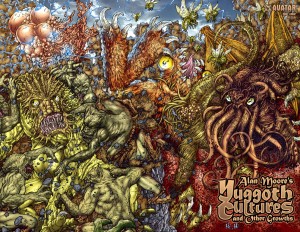
In the same issue Ryp also illustrates Moore’s poem, Zaman’s Hill, with two pieces that are the perfect representation of the underdark, maybe even the platonic ideal of the underdark (of which all other underdarks are shadows). My penchant for hyperbole aside, when I flipped to this page I was immediately struck by the thought, ‘so that’s what the underdark looks like’ (click on the pictures to see for yourself). And that’s a bit odd, since 25 years of D&D illustrations haven’t made me think that. Considering that the underdark plays such a huge role in the imagination of D&D, there are very few visual representations of it (there are many pictures of the creatures that live there though). That’s probably because there just aren’t that many landscapes in D&D illustration in general (even though Larry Elmore was clearly a master of the style). And that makes sense. Monsters are just more interesting (I am obsessed with them) and more immediate then the places which spawn them. But a great picture can transcend that generalization and I think that Ryp’s does.
In the D&D game I currently play in, my character the Jack of Clubs and his companions are working their way through a 4e adaptation of The Night Below boxed set. We’ve fought all manner of subterranean beasts (troglodytes, trolls, grell, and a behir) and I’ve never had trouble playing out those epic struggles in my mind. But when it comes to the underdark itself I feel as though my mind’s eye has formed only a crude backdrop against which our adventures play out. These pictures have changed that. My imagination is already filling those unsettling caverns with chanting Troglodytes, the maddening psionic hum of illithid mind-song, and the glittering trails of abolethic mucous chariots. The next time someone in your game wants to know what the underdark looks like, you have your answer.
But that’s not all. Yuggoth Cultures made me realize that the fungi’s spores are still spreading, sending out shoots and occasionally, twisting back together. Many of Lovecraft’s ideas are so pervasive in popular culture they sometimes come about full circle to meet each other face to face. Way back in Dragon 324 (when you could still hold the magazine in your hands) James Jacobs had a great article on Lovecraft’s influence on D&D where he specifically mentions the Lovecraftian influence on the creation of the underdark… and that’s how a pair of pictures in a comic completely unrelated to D&D come to perfectly represent one of the game’s greatest locales. Two mutant growths, sired from the same rhizome, but cultured in entirely different mediums, turn out to be twins.
